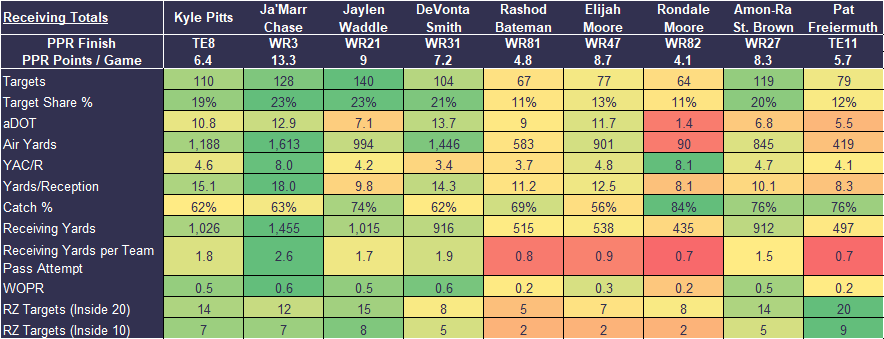 Compete in Weekly Drafts & Player Props Contests! Use Promo-Code: YARDSPER for a 100% deposit match up to $100!
Compete in Weekly Drafts & Player Props Contests! Use Promo-Code: YARDSPER for a 100% deposit match up to $100!
2021 Projections Review – Part 3: Rookies
Prior to the 2021 fantasy football season kicking off, I completed my full team projections for every team based on my assumptions of what I thought was a likely outcome for the season. If you haven’t done projections before, I wrote an article last offseason on how to do it and Yards Per Fantasy has a projections template that you can use. Both the article and the template will be updated this offseason so watch this space.
I’m going to spend some time in the early part of the offseason working through my assumptions and comparing them to what played out. I’m not going to spin takes and try to justify whether I’m a genius or an idiot, I’m simply looking at the process and comparing it to the results so I can adjust moving forward.
For Part 3 of the series, I’m going to have a look how the Rookies went in the first season. What sort of market share of the touches did they get, how far downfield were the receivers targeted, how good were they with the ball in their hands, etc. Once again, I won’t get in to total targets or total yards as they are heavily driven by the team stats that I reviewed in Part 1 of this review series. Instead, it will be their share of those totals and their efficiency on a per-touch basis.
Receivers

Kyle Pitts finished with a 19-percent target share, a 10.8 aDOT (average Depth Of Target) and a 4.6 YAC/R (Yards After Catch per Reception), resulting in 15.1 Yards/Reception. My projection was a 17-percent target share, a 7.5 aDOT and 4.8 YAC/R giving 10.8 Yards/Reception. He obviously overperformed against my expectation so did I just under-estimate him? Maybe. But Atlanta also lost Calvin Ridley for large parts of the season which no doubt changed the way players in this team were used.
Ja’Marr Chase, as we know by now, is a freak. His 23-percent target share is a tick over the 20-percent I projected, and a 12.9 aDOT is again a smidge higher than my projection of 12. However, 8.0 YAC/R is big time and almost double my projection. I will be reviewing an exercise I’ve done in the last couple of offseasons which tracks aDOT to YAC. In short, the bigger the aDOT the lower the YAC opportunity, and based on Chase’s aDOT his YAC is in the next stratosphere. The one player that jumped to my mind where I’ve seen this before was AJ Brown, but he didn’t have anywhere near the number of targets that Chase got when he did it.
Jaylen Waddle’s 23-percent target share surpassed my expectation of 13-percent but it’s worth remembering the injuries that this Dolphins team suffered. I projected a good target share for Will Fuller which never eventuated and Devante Parker’s absence for a stretch freed up some more targets. His 7.1 aDOT doesnt come as a surprise to anyone who watched this team play and was a tick down from my projection of 8. His YAC/R of 4.2 is disappointingly low considering his target depth, they need to do more to get him in space to make plays next season.
Devonta Smith’s 21-percent target share was pretty damn close to my 20-percent projection but he was a bigger downfield presence than I anticipated (aDOT of 13.7 against a projection of 10.5) and his YAC/R of 3.4 leaves a lot to be desired. He also falls short in the red zone target department with almost half of Waddle’s targets in the same area.
Bateman and the Moore ‘brothers’ were hampered by injuries so its unfair to really take too much from their target shares. I was a bit low on Bateman’s aDOT but high on his YAC, which is exactly the same story for my Elijah Moore projection. As for Rondale Moore, well that was just strange all round!
Amon-Ra St Brown got the opposite injury impact as last man standing bumped his target share. I wasn’t too far off on the aDOT and YAC but didn’t quite go low enough.
For Pat Freiermuth, I projected a bigger role from Eric Ebron this season so the rookie’s final standings were somewhat of a conglomeration of the two projections. The 12-percent target share is where I had Ebron, aDOT was 2 Ben Roethlis-yards shorter than I projected and the YAC was about right. My biggest observation with Freiermuth is the red zone targets. Over 25-percent of his targets were in the red zone, that’s huge and that screams regression to me.
Overall
Chase, Waddle, Elijah Moore, and St Brown significantly outperformed my expectations. Bateman and Devonta Smith landed within a couple of spots of my rankings, and Rondale Moore fell short.
Pitts didn’t quite live up to my lofty ranking of TE5 and Freiermuth smashed my low ranking out of the park with his red zone work.
Takeaway
Range of outcomes. What happens if that aDOT creeps a little bit in each direction? What happens if he isn’t used as a slot receiver but actually plays on the outside? What’s the upside if a team-mate goes down? That’s where I’m going to be looking more in this upcoming offseason. Look at the draft capital, the outcome you’d need to return value and then what the likelihood is of them exceeding that expectation. That’s the upside, that’s how we find league-winners like Ja’Marr Chase.
Running Backs

A 75-percent Rush share is massive, and Najee Harris put himself in top top company with that kind of workload. I had him as a high share back but fell a little short with an expectation that other backs would fill in a little more from time to time. His YPC (Yards Per Carry) is bad, but exactly where I projected it to be.
I correctly projected a split backfield in Denver for Javonte but I had Teddy and the other backs taking a touch more of both Melvin’s and Javonte’s shares. As for YPC, that fell out pretty much where projected (4.4 versus 4.5).
Elijah Mitchell wasn’t on my radar as a serious contender for touches but I’m going to cheat here. I projected a 40-percent share for Raheem Mostert and I’m going to tell you that share transferred to Mitchell as his direct replacement.
I significantly underestimated Michael Carter’s share of touches although injuries in the Jets backfield did free up some more opportunity for him along the way. I did the same for Rhamondre Stevenson who I anticipated to be more of a bit-part player than he was.
Chuba Hubbard and Khalil Herbert were projected only as handcuffs with a minor part and I hugely overestimated Trey Sermon’s role in the 49ers backfield.
Kenneth Gainwell landed in the right spot though with a 12-percent rush share against a projection of 13-percent and a 4.3 YPC against a projection of 4.2.
Overall
With the exception of Trey Sermon, every single one of these rookie running backs outperformed my ranking projection.
Takeaway
Range of outcomes springs to mind again here. We all know that there’s a chance of snagging the Chuba Hubbard and Khalil Herbert’s off waivers if the starters go down (unless we have a deep enough bench to carry them), but what about the others?
The biggest takeaway with running backs is the same every year though, volume is king. What is the competition like in the backfield and how many things need to happen for that player to take the lions share? If that number is low, then they’re worth a bigger shot.
Summary
Rookies are unpredictable but there’s definitely things we can learn here. Range of outcomes is huge and the players with pedigree can have monstrous ceilings in the right circumstances (I’m looking at you Mr Chase).
When it comes to running backs, a focus on offensive tendencies can tell us a lot. The Steelers have always liked to use a workhorse back, and Trey Sermon (in hindsight) was not a Shanahan-type running back – Elijah Mitchell was though…
The biggest thought in my mind this offseason will be ‘what needs to happen for this player to beat his draft value’. If that story isn’t too hard to dream up then we could be on to something.
Keep an eye out for the next phases of my projections assessments and our updated projections guide and template.
RANKINGS | DYNASTY |
 Play DFS on Outlast now! Use promo code: YPF200 to receive a 100% deposit match up to $200!
Play DFS on Outlast now! Use promo code: YPF200 to receive a 100% deposit match up to $200!






